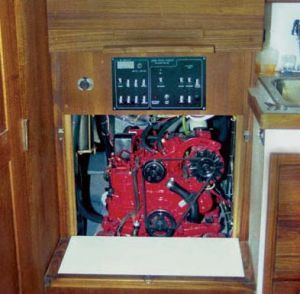 Next time you are headed to your boat take this with you and see if any apply to your circumstance. If you don’t understand something on the list contact me and I will be happy to explain!
Next time you are headed to your boat take this with you and see if any apply to your circumstance. If you don’t understand something on the list contact me and I will be happy to explain!
Bill Gladding 904-945-0511
Bill@gladdingmarinesurvey.com
No high bilge water alarm – Based on a formula in the US Navy Salvor’s Handbook a 2″ hole 3′ below the waterline floods at a rate of 136 gallons per minute. If your hull displaces 38,000 lbs. at 8.34 lbs/gallon that is roughly 4556 gallons. At a rate of 136 gallons per minute your hull will require only about 34 minutes to fill with water (assuming none is being removed and you do not have watertight bulkheads) to a level equaling its displacement. Having de watering pumps aboard and watertight bulkheads buys you some time. It is important to know water is coming in so you can fix the problem before it gets out of hand!
No pressure gauge on LPG system – LPG systems should have locker vapor tight to hull interior, regulator, pressure gauge and remotely operated solenoid valve (switch adjacent to LPG appliance of thereabouts). Pressure gauge is how you prove the integrity of your system. Test as described by ABYC A-1 1.10.3.1: With the appliance valves off, open the cylinder supply valve. Close the cylinder supply valve. Observe the pressure gauge reading. The pressure indicated should remain constant for not less than three minutes. If any leakage is indicated by a drop in pressure, check the entire system with a leak detection fluid or detergent solution to locate the leak. Test solutions shall be non-corrosive and non-toxic. Repairs shall be made before retesting and operating the system.
No means provided for unassisted re boarding from in the water – If you go overboard while anchored or in a marina that does not have floating docks you can pull yourself onto will you be stuck in the water? There may be circumstances where you may find yourself in trouble while in comfortable surroundings. On deck or returning to board alone only to find yourself in the water without a helping hand. Make sure you have allowed means to help yourself. Time may be of the essence.
No CO monitors in areas of vessel interior where passengers will be sleeping – I was explaining why this was important to an owner of a diesel powered sailboat while I was conducting an insurance survey on his boat. I explained that other boats in the marina had gas engines and he might be resting aboard when one of his neighbors came down to exercise his engines and generator. He gave me the yeah right look which a short time later turned to a look of realization when two boats away one of his neighbors fired up his engines and generator and we could smell the fumes! CO monitors are cheap insurance against the unexpected…
Fire extinguishers over 12 years old – Cylinders are required to be hydro-tested after 12 years. It is not cost effective to do so to the small portable extinguishers. It is also common to find the extinguishing agent compacted/caked solid inside old extinguishers. If the powder cannot be felt to be loose inside they should be discarded and replaced.
Fixed fire system never inspected – A qualified technician will confirm the system is sized properly and test the engine shut-down relay if installed so you know that the system will perform properly when triggered.
- Anchor chain bitter end made fast to hull with shackle versus line (line allows quick means of parting rode in case of emergency)
- Improper arrangement or mounting of navigation lights and inoperative navigation lights
- Inoperative underwater thru-hull valves
- Inverters installed without overcurrent protection and/or battery disconnect
- Hatches in areas that could flood that are not well secured or have serviceable gaskets
- Engine heated water heaters that have hoses not rated for engine cooling system operating temperature
- Burned out and/or leaking fiberglass exhaust pipes, broken and missing clamps on exhaust hose connections
- Corroded and broken hose clamps on propeller shaft packing gland hoses
- Vessel not properly grounded (AC green ground not connected to DC negative and bonding system)
- Offshore vessels with no Epirb or Type I offshore lifejackets
- Additional shore power inlet fittings installed without transfer switches so unused inlets are energized posing shock hazard to curious fingers
- Missing locking collars on boat end of shore power cords
- No overcurrent protection on main DC power supply cables leading to panels
Check back again sometime as I will be updating this list periodically.